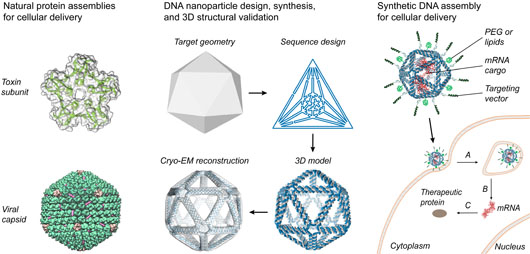Toxins and viruses have evolved a remarkable capacity to infect specific organs, tissues, and cells, where they proliferate or cause cellular death that leads to human disease. Despite decades of research into the cellular targeting and delivery mechanisms by which these natural protein assemblies accomplish this remarkable task, re-engineering their function to deliver messenger RNAs, genes, and CRISPR/Cas9 for therapeutic purposes remains challenging.
As an alternative, we invented a class of fully customizable, synthetic DNA-based nanoparticles that offer full control over the internal cargo that they carry, as well as the targeting vectors that they present to facilitate their delivery. Based on an HFSP-funded project, the Bathe Lab conceived of this versatile framework to facilitate the collaborative team’s goal of testing the biological roles of Shiga toxin structural organization on cellular delivery and trafficking. This line of research ultimately aims to realize the major goal of programmed cellular delivery that requires robust endosomal escape from the cellular degradation pathway to facilitate therapeutic mRNA or CRISPR/Cas9 action.

Figure: Designer DNA nanoparticles for cellular delivery. Left panel: Two examples of natural protein assemblies involved in cellular delivery: the Shiga toxin B-subunit pentamer (PDB ID 1C48) and the icosahedral capsid of an adenovirus (PDB ID 4CWU). Center panel: Top-down computational design strategy for fully automatic sequence design of arbitrary DNA nanoparticle geometries and sizes on the 5 to 100 nanometer scale. Right panel: DNA nanoparticles can be functionalized externally with diverse vectors for targeting cellular delivery including toxins, peptides, and lipids, as well as loaded internally with messenger RNA cargo for therapeutic or other cell biological purposes. As an illustrative example the DNA nanoparticle binds the cell surface and is subsequently (A) internalized via endocytosis followed by (B) endosomal escape from degradation that enables (C) messenger RNA translation in the cytosol.
With our versatile synthetic framework now in place, our team is pursuing application of diverse toxin organizations using these highly programmable DNA nanoparticle geometries, as well as incorporating messenger RNA and CRISPR/Cas9 cargo internally to eventually apply these constructs to targeted protein translation and gene editing in situ. The design tool associated with our approach is available for free use by the broader synthetic structural biology community at http://daedalus-dna-origami.org.
Reference
Designer nanoscale DNA assemblies programmed from the top down. Veneziano, R., Ratanalert, S., Zhang, K., Zhang, F., Yan, H., Chiu, W., Bathe, M. Science, 352: 1534 (2016).


































